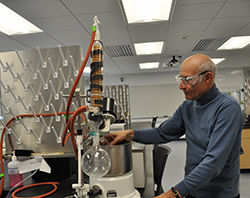"Four Mechanisms in Reactions of 3-Aminopyrrole with 1,3,5-Triazines ? " So, what does this mean? To those who aren't chemists, this may look like a group of random words thrown together with some numbers in between. But to Penn State Brandywine Professor of Chemistry Michael De Rosa and his student research team, this looks like the possibility of a future medical discovery.
Four Penn Staters had the opportunity to conduct research with De Rosa during the summers of 2011 and 2012, which was funded by a National Science Foundation (NSF) grant.
The team managed to create an organic compound called 3-aminopyrrole, which has never been produced before. Furthermore, the reactions that took place while working with the compound have never been seen before. Why is this meaningful to the average person?
"These kinds of reactions can be used to make compounds that have potential medicinal uses," De Rosa explained. "It [the compound] needs to be tested. Usually somebody makes the compounds and somebody else does the testing. Is it anti-cancer? Does it inhibit cell growth? Does it work against bacteria?"
These are the questions that could be answered through future testing.
The Brandywine professor has been working with undergraduate students since 1990. He had fun with the team and was happy to have the chance to work alongside such a dedicated group.
Penn State graduate Douglas Hartline, who attended Brandywine before transferring to University Park, was able to play a major part in the research. "I learned a lot from working under Dr. De Rosa in his lab," he said. "The experience was a little different each day, but very exciting at the same time." Hartline is currently attending Purdue University where he is earning his doctorate in chemistry.
David Arnold, a former Brandywine student who later graduated from Kings College, came back to the Brandywine lab to work on the project. De Rosa explained that Arnold was able to help lead the undergraduate students in their research efforts since he had additional experience, having earned his master's degree from the University of Pittsburgh.
Young Son, who is studying at University Park after completing his freshman and sophomore years at Brandywine, said, "participating in this degree of research was an honor for me." Son plans on attending medical school after graduating and described working with De Rosa as a "privilege."
Penn State student Austin Cameron Wright found the opportunity to conduct research with De Rosa online. Home for the summer from University Park, he thought working at Brandywine would be a great way to gain experience. "This work is valuable because it opens up new synthetic pathways with which chemicals can be made," he said. "These chemicals may play important roles in the synthesis of pharmaceuticals or industrial chemicals, which will eventually help the lives of everyday people."
"Four Mechanisms in the Reactions of 3-Aminopyrrole with 1,3,5-Triazines: Inverse Electron Demand Diels-Alder Cycloadditions vs SNAr Reactions via Uncatalyzed and Acid-Catalyzed Pathways" was published in The Journal of Organic Chemistry, 2013, 78 (17), pp 8614-8623. Arnold, De Rosa and Hartline were all named as authors.
De Rosa will travel to Seoul, Republic of Korea in October to present these findings at the 14th Tetrahedron Symposium-Asia Edition. All five researchers were named as authors on the accepted presentation.
